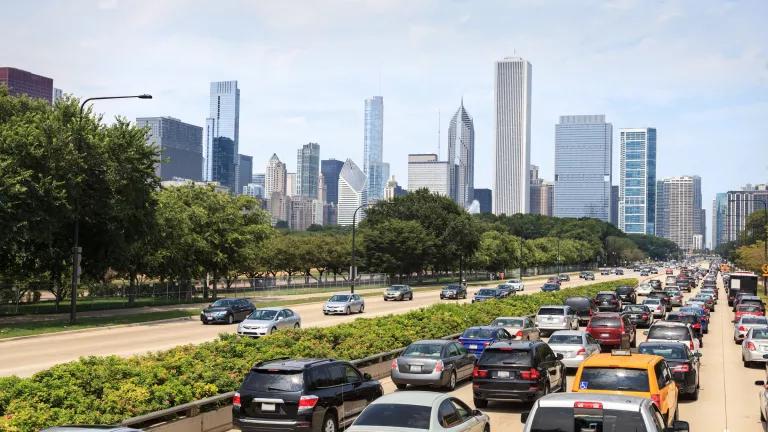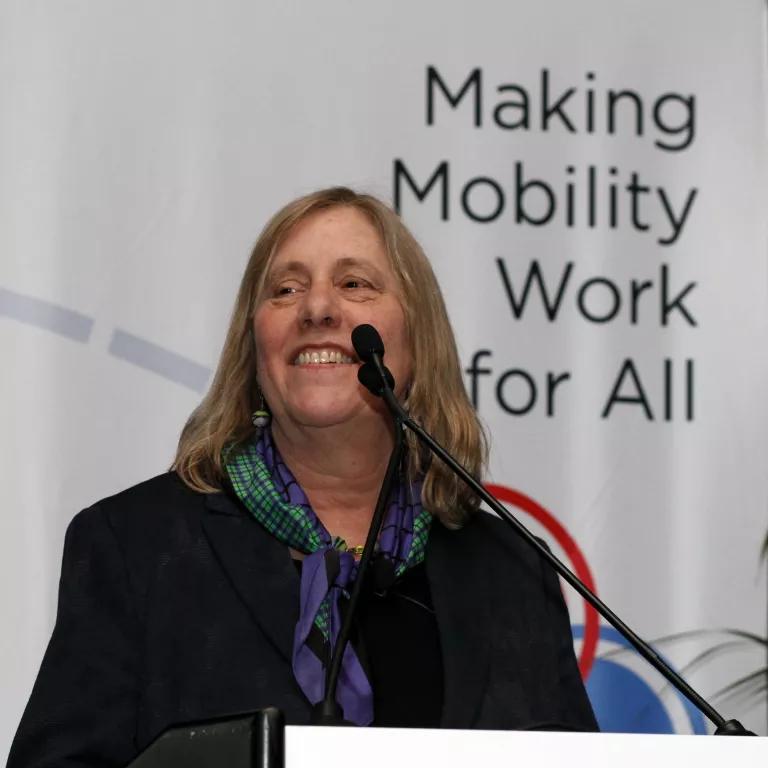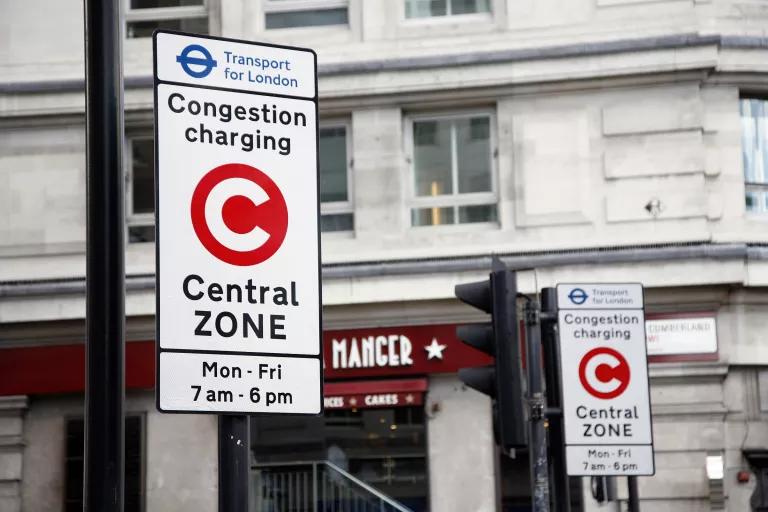Can a New Tax on Uber and Lyft Rides in Chicago Change Commuting Habits?
A surcharge on trips taken with ride-hailing services could reduce traffic, cut emissions, and help fund much-needed public transit improvements on the South and West Sides of the city.

Traffic into Downtown Chicago
In Chicago’s Loop, traffic abounds. Commuters board buses, city workers maneuver trucks, and cars of every make and model festooned with Lyft, Uber, and Via lights pick passengers up and drop them off. Though the thrum of blaring horns and idling engines is nothing new downtown, the past few years have seen a marked increase in the number of vehicles on city streets. And despite early claims that they would decrease congestion, ride-hailing companies have played a big part in that trend, according to city officials and public transit advocates.
“Choosing to ride by Uber or Lyft is having ripple effects on everyone else who is traveling in and out of that busy area,” says Kyle Whitehead, a spokesman for Chicago’s Active Transportation Alliance. Since 2015, in the third-largest city in the country, trips provided by these and other ride-hailing companies have increased by more than 250 percent.
Roughly half of those rides either start or end in the Loop, the city’s central business district, and 77 percent of them are taken by a solo passenger. “The heart of congestion is the single-occupancy vehicle,” says Sharon Feigon, director of the nonprofit Shared-Use Mobility Center. “When we went from taxis to the emergence of Uber and Lyft, the demand for those kinds of rides on an app skyrocketed.”

Shared rides, on the other hand, are requested primarily from the South and West Sides, neighborhoods with fewer public transit options and home to some of the city’s lower-income communities. Last year, fares for those shared trips increased. Fares for single rides, however, did not, according to a Reuters investigation conducted last November, despite solo passengers having a higher impact on the city’s traffic flow and transportation-related carbon emissions.
To address increasing inequities, traffic, and air pollution on the city’s streets, the Chicago City Council passed a congestion tax on ride-hailing trips in November. The plan, which went into effect in January, significantly increases the tax on solo rides provided by companies like Uber and Lyft. Specifically, each solo rider into or out of downtown will pay a $3 tax, which is $2.28 more than the prior surcharge and about the same price as a ride on public transit. Passengers sharing downtown rides will pay a $1.25 tax—the same charge that will go into effect for people taking single rides outside of downtown. Meanwhile, the tax on shared rides outside of downtown would decrease by $0.07 to $0.65 per ride.
To arrive at these changes, a team that included Mary Nicol, a Chicago-based NRDC climate advisor with the American Cities Climate Challenge, analyzed data that are provided quarterly by the ride-hailing companies. Their findings appeared in a report, published by the city in October, that outlined how people use these private transportation services and their impact on the city. That information helped the city identify where and when a tax would be most effective: downtown between 6 a.m. and 10 p.m., when public transit is available and accessible.
The plan is expected to generate $40 million annually in revenue for the city, a portion of which will go toward capital improvements to its transit system. “It’s part of the mayor’s platform of continuing to ensure that all residents have access to a safe, equitable, and sustainable transportation system,” Nicol says.
Other cities, including London, Stockholm, and New York, have also adopted various congestion pricing plans, and additional metropolises across the United States are considering similar measures. In London, the number of vehicles in the congestion zone decreased by 15 percent after the tax went into effect. In Stockholm, it fell by 20 percent. In New York, all vehicles entering a designated zone will pay a tax beginning in 2021, and experts predict similar decreases in vehicle traffic.

Reducing the number of vehicles on the road not only allows passengers to get from one place to another faster but also leads to fewer tailpipe emissions, which is the country’s second-biggest source of greenhouse gases. In Chicago, transportation accounts for more than a quarter of the city’s greenhouse gas emissions, according to a 2018 Chicago Metropolitan Agency for Planning report.
Air quality also improves. A study published in 2017, one of the first to look at the health effects of a congestion tax, showed that in Stockholm’s city center a few years after the tax went into effect, childhood asthma attacks had decreased by nearly half. Levels of nitrogen dioxide had fallen by 5 percent, and levels of particulate matter (which includes the leftovers from burning gasoline, among other airborne pollutants) were down by 10 percent.
Transportation experts hope Chicago will experience those benefits too. “In terms of economic development, in terms of doing our part to reduce climate change, we really do need to make sure that we’re deprioritizing the single-occupancy vehicle,” says Feigon.
Ride-hailing companies, of course, are just one source of Chicago’s street-level congestion and pollution. The city will use some of the congestion tax revenue to conduct a study on how other vehicles use its roads. Findings from that research could lead to a more comprehensive fee or incentive structure that extends to trucks and freight, which could further drive down emissions.
But the most effective way to accomplish that is to improve public transit and encourage biking and walking. In tandem with the growth of private transportation services in Chicago, bus and train use has been steadily declining. Since 2012, a year after Uber began operating in the city and one year before Lyft arrived, bus ridership has decreased by 17 percent, according to the Active Transportation Alliance.
Some critics point to unreliable and slow bus service as the reason. People used to puzzle over how to get more vehicles down a corridor; now the priority is shifting toward accommodating more riders, says Audrey Wennink, director of transportation for the Chicago-based Metropolitan Planning Council. But as long as buses are given no priority treatment on the roads, people lack incentive to choose public transit over driving or ride hailing.

The city is working to change that. The Chicago Department of Transportation announced last October that it would increase funding from $5 million to $20 million to develop seven bus priority zones, areas with dedicated bus lanes that help make public transit reliable and fast, particularly on the South and West Sides. (Proposed train improvements on the South Side are also in the works.) Part of the revenue from the congestion tax will help that effort.
Still, the city will need to secure further funds from state and federal sources to vastly improve the bus system and make sure it works for all riders, says Whitehead. But he adds that the congestion tax—in effect, a disincentive to commute by car—offers a step in the right direction: “You also have to make it more difficult for people to drive alone into the Loop at 8:30 in the morning.”
This NRDC.org story is available for online republication by news media outlets or nonprofits under these conditions: The writer(s) must be credited with a byline; you must note prominently that the story was originally published by NRDC.org and link to the original; the story cannot be edited (beyond simple things such as grammar); you can’t resell the story in any form or grant republishing rights to other outlets; you can’t republish our material wholesale or automatically—you need to select stories individually; you can’t republish the photos or graphics on our site without specific permission; you should drop us a note to let us know when you’ve used one of our stories.

The City Insider Proving that Mayors Can Lead on Climate
How You Can Stop Global Warming
A Consumer Guide to the Inflation Reduction Act